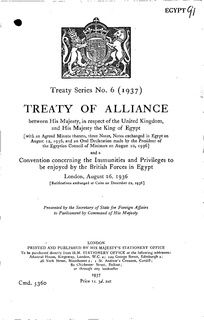 W
WThe Anglo-Egyptian Treaty of 1936 was a treaty signed between the United Kingdom and the Kingdom of Egypt. Under the terms of the treaty, the United Kingdom was required to withdraw all its troops from Egypt, except those necessary to protect the Suez Canal and its surroundings, numbering 10,000 troops plus auxiliary personnel. Additionally, the United Kingdom would supply and train Egypt's army and assist in its defence in case of war. The treaty was to last for 20 years; it was negotiated in the Zaafarana palace, signed in London on 26 August 1936 and ratified on 22 December. It was registered in League of Nations Treaty Series on 6 January 1937.
 W
WThe Anglo-German Naval Agreement (AGNA) of 18 June 1935 was a naval agreement between Great Britain and Germany regulating the size of the Kriegsmarine in relation to the Royal Navy.
 W
WThe Anglo-Iraqi Treaty of October 1922 was an agreement signed by the government of Great Britain and the government of Iraq. The treaty was designed to allow for local self-government while giving the British control of foreign and military affairs. It was intended to conclude an agreement made at the Cairo Conference of 1921 to establish a Hashemite Kingdom in Iraq.
 W
WThe 1921 Anglo-Irish Treaty, commonly known as The Treaty and officially the Articles of Agreement for a Treaty Between Great Britain and Ireland, was an agreement between the government of the United Kingdom of Great Britain and Ireland and representatives of the Irish Republic that concluded the Irish War of Independence. It provided for the establishment of the Irish Free State within a year as a self-governing dominion within the "community of nations known as the British Empire", a status "the same as that of the Dominion of Canada". It also provided Northern Ireland, which had been created by the Government of Ireland Act 1920, an option to opt out of the Irish Free State, which it exercised.
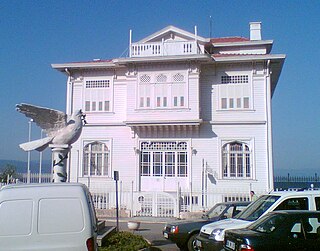 W
WThe Armistice of Mudanya was an agreement between Turkey on the one hand, and Italy, France and Britain on the other hand, signed in the Ottoman town of Mudanya, in the province of Bursa, on 11 October 1922. The Kingdom of Greece acceded to the armistice on 14 October 1922.
 W
WThe Balkan Pact, or Balkan Entente, was a treaty signed by Greece, Turkey, Romania and Yugoslavia on 9 February 1934 in Athens, aimed at maintaining the geopolitical status quo in the region following World War I. To present a united front against Bulgarian designs on their territories, the signatories agreed to suspend all disputed territorial claims against each other and their immediate neighbors which followed in the aftermath of the war and a rise in various regional ethnic minority tensions. Other nations in the region that had been involved in related diplomacy refused to sign the document, including Italy, Albania, Bulgaria, Hungary and the Soviet Union. The pact became effective on the day that it was signed. It was registered in the League of Nations Treaty Series on 1 October 1934.
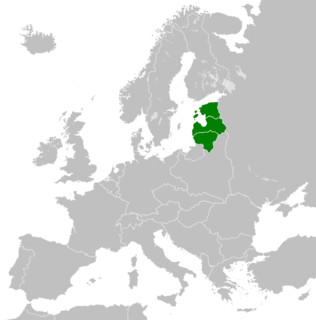 W
WThe Baltic Entente was based on Treaty of Good-Understanding and Co-operation signed between Lithuania, Latvia, and Estonia on September 12, 1934 in Geneva. The main objective of the agreement was joint action in foreign policy. It also included commitments to support one another politically and to give diplomatic support in international communication. The endeavour was ultimately unsuccessful, as the combined strength of the three nations and their statements of neutrality were insubstantial in the face of the massive armies of Nazi Germany and the Soviet Union.
 W
WThe Convention between Italy and Turkey, signed in Ankara on January 4, 1932, by the Italian Plenipotentiary, Ambassador Pompeo Aloisi, and the Turkish foreign minister Tevfik Rüştü Aras, settled a dispute that had arisen in the aftermath of the Treaty of Lausanne of 1923, about the sovereignty over a number of small islets and the delimitation of the territorial waters between the coast of Anatolia and the island of Kastellórizo, which was an Italian possession since 1921.
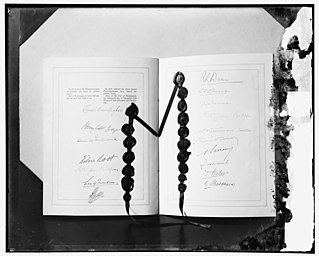 W
WThe Four-Power Treaty was a treaty signed by the United States, United Kingdom, France and Japan at the Washington Naval Conference on 13 December 1921. It was partly a follow-on to the Lansing-Ishii Treaty, signed between the U.S. and Japan.
 W
WThe Franco-Italian Agreements were signed in Rome by both French Foreign Minister Pierre Laval and Italian Prime Minister Benito Mussolini on January 7, 1935.
 W
WThe Franco-Syrian Treaty of Independence, also known as the Viénot Accords, was a treaty negotiated between France and Syria to provide for Syrian independence from French authority.
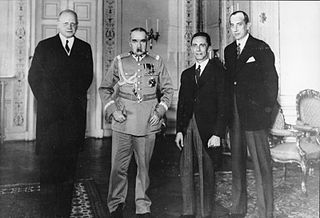 W
WThe German–Polish Non-Aggression Pact was an international treaty between Nazi Germany and the Second Polish Republic that was signed on January 26, 1934. Both countries pledged to resolve their problems by bilateral negotiations and to forgo armed conflict for a period of 10 years. The pact effectively normalised relations between Poland and Germany, which had been strained by border disputes arising from the territorial settlement in the Treaty of Versailles. Germany effectively recognised Poland's borders and moved to end an economically-damaging customs war between the two countries that had taken place over the previous decade.
 W
WThe Italo-Yemeni Treaty of 1926 was a treaty between the Kingdom of Italy and Mutawakkilite Kingdom of Yemen. The treaty was signed in September 1926 and was described as a friendship treaty. At the time, Italy was ruled by the fascist National Fascist Party with Benito Mussolini as head of government. The treaty recognized Imam Yahya Muhammad Hamid ed-Din as King of Yemen and acknowledged his claims to Aden. The treaty was renewed on October 15, 1937, after Italy had annexed Abyssinia.
 W
WThe Kellogg–Briand Pact is a 1928 international agreement in which signatory states promised not to use war to resolve "disputes or conflicts of whatever nature or of whatever origin they may be, which may arise among them". There were no mechanisms for enforcement. Parties failing to abide by this promise "should be denied of the benefits furnished by [the] treaty". It was signed by Germany, France, and the United States on 27 August 1928, and by most other states soon after. Sponsored by France and the U.S., the Pact renounced the use of war and calls for the peaceful settlement of disputes. Similar provisions were incorporated into the Charter of the United Nations and other treaties, and it became a stepping-stone to a more activist American policy. It is named after its authors, United States Secretary of State Frank B. Kellogg and French foreign minister Aristide Briand. The pact was concluded outside the League of Nations and remains in effect.
 W
WThe Lateran Treaty was one component of the Lateran Pacts of 1929, agreements between the Kingdom of Italy under Benito Mussolini and the Holy See under Pope Pius XI to settle the long-standing Roman Question. The treaty and associated pacts were named after the Lateran Palace where they were signed on 11 February 1929, and the Italian parliament ratified them on 7 June 1929. The treaty recognized Vatican City as an independent state under the sovereignty of the Holy See. The Italian government also agreed to give the Roman Catholic Church financial compensation for the loss of the Papal States. In 1947, the Lateran Treaty was recognized in the Constitution of Italy as regulating the relations between the state and the Catholic Church.
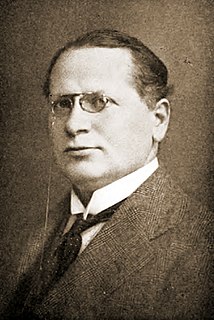 W
WThe Litvinov Protocol is the common name of an international peace treaty concluded in Moscow on February 9, 1929. Named after the chief Soviet diplomat moving the negotiations forward, Maxim Litvinov, the treaty provided for immediate implementation of the Kellogg-Briand Pact by its signatories, thereby formally renouncing war as a part of national foreign policy.
 W
WThe Locarno Treaties were seven agreements negotiated at Locarno, Switzerland, during 5–16 October 1925 and formally signed in London on 1 December, in which the First World War Western European Allied powers and the new states of Central and Eastern Europe sought to secure the post-war territorial settlement, in return for normalizing relations with the defeated German Reich. It also stated that Germany would never go to war with the other countries. Locarno divided borders in Europe into two categories: western, which were guaranteed by Locarno treaties, and eastern borders of Germany with Poland, which were open for revision.
 W
WThe London Naval Treaty was an agreement between the United Kingdom, Japan, France, Italy and the United States, signed on 22 April 1930. Seeking to address a loophole in the formidable 1922 Washington Naval Treaty, it regulated submarine warfare and limited naval shipbuilding. Ratifications were exchanged in London on 27 October 1930, and the treaty went into effect on the same day. It was largely ineffective.
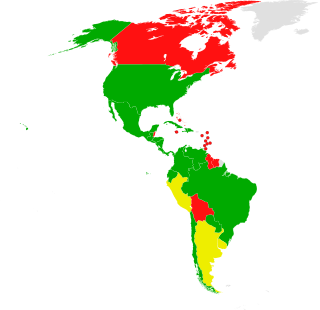 W
WThe Montevideo Convention on the Rights and Duties of States is a treaty signed at Montevideo, Uruguay, on December 26, 1933, during the Seventh International Conference of American States. The Convention codifies the declarative theory of statehood as accepted as part of customary international law. At the conference, United States President Franklin D. Roosevelt and Secretary of State Cordell Hull declared the Good Neighbor Policy, which opposed U.S. armed intervention in inter-American affairs. The convention was signed by 19 states. The acceptance of three of the signatories was subject to minor reservations. Those states were Brazil, Peru and the United States.
 W
WThe Nine-Power Treaty (Japanese: Kyūkakoku Jōyaku or Nine-Power Agreement was a 1922 treaty affirming the sovereignty and territorial integrity of the Republic of China as per the Open Door Policy. The Nine-Power Treaty was signed on 6 February 1922 by all of the attendees to the Washington Naval Conference: the United States, Belgium, China, France, Great Britain, Italy, Japan, the Netherlands, and Portugal.
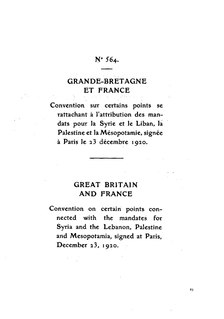 W
WThe Paulet–Newcombe Agreement or Paulet-Newcombe Line, was a 1923 agreement between the British and French governments regarding the position and nature of the boundary between the Mandates of Palestine and Iraq, attributed to Great Britain, and the Mandate of Syria and Lebanon, attributed to France. The 1923 line defined the border of Mandatory Palestine from the Mediterranean up to Al-Hamma, Tiberias. The 1920 line defined, in less detail, the border of the French Mandate for Syria and Lebanon from the Mediterranean up to Jeziret-ibn-Omar.
 W
WThe Treaty of Rapallo was an agreement signed on 16 April 1922 between the German Republic and Russian Soviet Federative Socialist Republic (RSFSR) under which each renounced all territorial and financial claims against the other following the Treaty of Brest-Litovsk and World War I.
 W
WThe Reichskonkordat is a treaty negotiated between the Vatican and the emergent Nazi Germany. It was signed on 20 July 1933 by Cardinal Secretary of State Eugenio Pacelli, who later became Pope Pius XII, on behalf of Pope Pius XI and Vice Chancellor Franz von Papen on behalf of President Paul von Hindenburg and the German government. It was ratified 10 September 1933 and it has been in force from that date onward. The treaty guarantees the rights of the Catholic Church in Germany. When bishops take office Article 16 states they are required to take an oath of loyalty to the Governor or President of the German Reich established according to the constitution. The treaty also requires all clergy to abstain from working in and for political parties. Nazi breaches of the agreement began almost as soon as it had been signed and intensified afterwards leading to protest from the Church including in the 1937 Mit brennender Sorge encyclical of Pope Pius XI. The Nazis planned to eliminate the Church's influence by restricting its organizations to purely religious activities.
 W
WThe Roca–Runciman Treaty was a commercial agreement signed on 1 May 1933 between Argentina and the United Kingdom signed in London by the Vice President of Argentina, Julio Argentino Roca, Jr., and the president of the British Board of Trade, Sir Walter Runciman.
 W
WThe Rome Protocols were a series of three international agreements concluded in Rome on 17 March 1934 between the governments of Austria, Hungary and Italy. They were signed by Italian Prime Minister Benito Mussolini, Austrian Chancellor Engelbert Dollfuss and Hungarian Prime Minister Gyula Gömbös. All of the protocols went into effect on 12 July 1934 and were registered in League of Nations Treaty Series on 12 December 1934.
 W
WThe Anti-war Treaty of Non-aggression and Conciliation was an inter-American treaty signed in Rio de Janeiro on October 10, 1933. It was the brain-child of Carlos Saavedra Lamas, who was Argentinian Minister of Foreign Affairs at the time the treaty was concluded. It was signed by representatives of Argentina, Brazil, Chile, Mexico, Paraguay and Uruguay. The US government acceded to the treaty on August 10, 1934. The treaty went into effect on November 13, 1935. It was registered in League of Nations Treaty Series on November 28, 1935.
 W
WThe Second London Naval Treaty was an international treaty signed as a result of the Second London Naval Disarmament Conference held in London, the United Kingdom. The conference started on 9 December, 1935 and treaty was signed by the participating nations on 25 March, 1936.
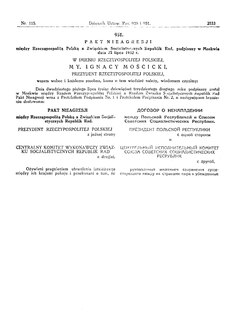 W
WThe Soviet–Polish Non-Aggression Pact was a non-aggression pact signed in 1932 by representatives of Poland and the Soviet Union. The pact was unilaterally broken by the Soviet Union on September 17, 1939, during the Soviet invasion of Poland.
 W
WThe Tanggu Truce, sometimes called the Tangku Truce , was a ceasefire that was signed between the Republic of China and the Empire of Japan in Tanggu District, Tianjin, on May 31, 1933. It formally ended the Japanese invasion of Manchuria, which had begun in 1931.
 W
WThe Tartu Peace Treaty or Treaty of Tartu is a peace treaty between Estonia and Russian Soviet Federative Socialist Republic signed on 2 February 1920, ending the Estonian War of Independence. The terms of the treaty stated "In consequence of the right of all peoples to self-determination, to the point of seceding completely from the State of which they form part, a right proclaimed by the Socialist and Federal Russian Republic of the Soviets, Russia unreservedly recognizes the independence and sovereignty of the State of Estonia, and renounces voluntarily and forever all sovereign rights possessed by Russia over the Estonian people and territory whether these rights be based on the juridical position that formerly existed in public law, or in the international treaties which, in the sense here indicated, lose their validity in future. " Ratifications of the treaty were exchanged in Moscow on 30 March 1920. It was registered in League of Nations Treaty Series on 12 July 1922.
 W
WThe Treaty of Rapallo was a treaty between the Kingdom of Italy and the Kingdom of Serbs, Croats and Slovenes, signed to solve the dispute over some territories in the former Austrian Littoral in the upper Adriatic, and in Dalmatia.
 W
WThe Treaty of Trianon was prepared at the Paris Peace Conference and was signed in the Grand Trianon Palace in Versailles on 4 June 1920. It formally ended World War I between most of the Allies of World War I and the Kingdom of Hungary. French diplomats played the major role in designing the treaty, with a mind to establishing French-led coalition of the newly formed nations. It regulated the status of the independent Hungarian state and defined its borders generally within the ceasefire lines established in November–December 1918 and left Hungary as a landlocked state that included 93,073 square kilometres (35,936 sq mi), 28% of the 325,411 square kilometres (125,642 sq mi) that had constituted the pre-war Kingdom of Hungary. The truncated Kingdom had a population of 7.6 million, 36% compared to the pre-war kingdom's population of 20.9 million. Though the areas that were allocated to neighbouring countries had a majority of non-Hungarians, in them lived 3.3 million Hungarians – 31% – who were now in a minority status. The treaty limited Hungary's army to 35,000 officers and men, and the Austro-Hungarian Navy ceased to exist. These decisions and their consequences have been the cause of deep resentment in Hungary ever since.
 W
WThe Treaty of Warsaw of April 1920 was a military-economical alliance between the Second Polish Republic, represented by Józef Piłsudski, and the Ukrainian People's Republic, represented by Symon Petliura, against Bolshevik Russia. The treaty was signed on 21 April 1920, with a military addendum on 24 April.
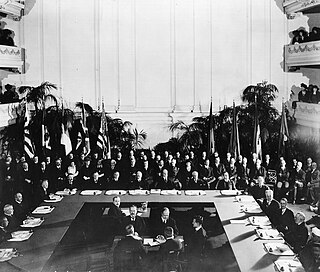 W
WThe Washington Naval Treaty, also known as the Five-Power Treaty, was a treaty signed during 1922 among the major Allies of World War I, which agreed to prevent an arms race by limiting naval construction. It was negotiated at the Washington Naval Conference, held in Washington, D.C., from November 1921 to February 1922, and it was signed by the governments of the United Kingdom, the United States, France, Italy, and Japan. It limited the construction of battleships, battlecruisers and aircraft carriers by the signatories. The numbers of other categories of warships, including cruisers, destroyers and submarines, were not limited by the treaty, but those ships were limited to 10,000 tons displacement each.